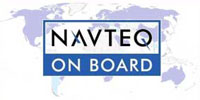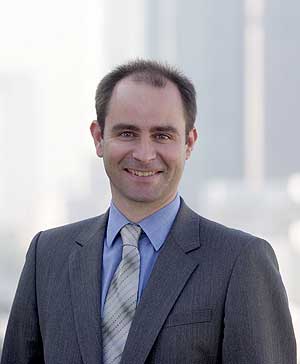|
|
 |
 |
 |
 |
Navteq on board: How Navteq educate retailers
Article by: Mike Barrett
Date: 25 Nov 2010
 A couple of weeks ago Navteq promoted a "Channels" marketing day at Stamford Bridge, home of Chelsea football team. We took the opportunity to catch up with what is going on inside the mapping company, but rather than our usual technical update we decided to find out about the Channel initiative. A couple of weeks ago Navteq promoted a "Channels" marketing day at Stamford Bridge, home of Chelsea football team. We took the opportunity to catch up with what is going on inside the mapping company, but rather than our usual technical update we decided to find out about the Channel initiative.
Eric Fumat who is VP, Channel Sales Development for EMEA made himself available to be interviewed. The topic we intended to cover were: how Navteq promote the brand to retailers; how the sales force are educated; what benefits Navteq receive from these initiatives; why Navteq feels the need to promote to the Channel rather than leave it up to their clients ie Garmin.
A little like the Intel campaign some years ago Navteq are attempting to raise the profile and understanding of the mapping contribution to SatNav and LBS markets. When talking about "The Channel" we are referring to the the big retail chains PCWorld, Currys, Halfords, Best Buy etc. The initiative is all about educating the store staff in the role Navteq play in the market, and to assist their partners in promoting the features of their products to the stores.
 Mike: "How do you promote the Navteq brand to retailers?" Mike: "How do you promote the Navteq brand to retailers?"
Eric: "Firstly I will explain how the Channel Sales Team works within Navteq.
The Channel Sales Team works on the "ingredients approach" to Navteq. So Navteq is an ingredient within navigation. There are a lot of ingredients, but no consumer will buy a Navteq whatever. We are a Business to Business company so your questions are more of how do we work closer to the consumer environment.
Our purpose here is to facilitate the Business to Business to Consumer and the Channels Sales Team within Navteq is unique organisation within the GPS world. We have 2 main high level functions:
Marketing producing tools to assist sales;
Channel Sales introducing people to the sales floors trade salespeople understand GPS world and the Retail world. Their job is to help bring both parties together to help Navteq partners sell more devices, increasing Navteq market share against competitors."
Mike: "How do you go about pulling this integration between your clients and the retailers together?"
Eric: "Lets take two examples:
Identifying promotions. A certain retailer may want to do a promotion with particular functionality at a specified price point. Navteq knows what is available in the market place and who is making the required product. We can bring the two together. You may say that our partners are in contact with the retailers and they could do the same thing themselves. We offer two advantages a single point of contact for all our clients, and we are not trying to sell anything there are different discussions than with our customers."
Mike: "So say Garmin was to go to a retailer they would be trying to sell a specific product but you are somewhat independent."
Eric: "We could work with Garmin to say: 'How can we make this promotion happen?' We would work in a three way co-operative promotion to make it work. We would never create a promotion of our own as we have nothing to sell to the consumer. But we would identify opportunities and bring them to our partners, or support our partners in opportunities that they have identified.
Then secondly there is Category Management were we say 'How can the store clerks sell better navigation?'. Again because we are not selling a product directly we can offer more impartial advice."
Mike: "These sales activities bring no direct benefit to Navteq so what does Navteq gain from this investment?"
Eric: "You are right there is no direct benefit, but there is an 'immediate indirect benefit' which is that if one of our partners increases their market share then we benefit as an ingredient supplier to the product. So it makes it a fairly direct benefit."
Mike: "When visiting retailers what sort of training or presentations do you give?"
Eric: "There are 2 important elements: Making sure they understand the importance of the map in the device or application and the second key objective is to make sure they know how the application works. We are combining these as much as possible, explaining the importance of the map makes little sense if they do not understand the operation of the application. We work with our partners to determine what we can say, to who, and how often to explain the value of a function in the application. Within that framework we highlight the value of the content to support the application to support the functionality.
The key to this is identifying what are the key selling arguments for the features and presenting them in the shortest amount of time possible. This can often be to sales staff or, for wireless operators, call centre staff."
Mike: "So does this mean you provide training to your partners as well?"
Eric: "Yes it is really both. The target is the sales force of our partners, not so much PND, but particularly automotive and wireless where navigation is not their main focus. Depending on the market segment it is not always the same priority. We provide support to grow the category and to grow our market share in the category."
Mike: " How do you deliver your training?"
Eric: "We are looking at different way to provide training. Depending on the audience it can be quite difficult to get to the people in the stores. We are looking at different tools and schemes to appeal to different audiences. We have face to face powerpoint tools, and now we have developed online eTraining to suit the time slots of the sales force."
Mike: "Where do carry out the face to face training? Client premises or central training facilities?"
Eric: "In general it is at the client's premises or in their retail stores."
Mike: "What topics do you cover in these training sessions?"
Eric: "What is the map, how is it built. Our aim is to provide an understanding about the underlying content element, including how it is built. Although this will be very quick and at a high level. The trainees attention span is often very short. The concept is to provide them with enough information to be able to explain the value of the map to the end user.
How the application works. Again a very quick overview, very focused. Then we will highlight a few key functionalities."
Mike: "When you say 'How the application works' do you use a specific device or application or is it more generic?"
Eric: "That is a good question. We can do it in a generic manner taking specific functionality and explaining that. It can also be done in conjunction with a partner in which case we would have a specific device and obviously a specific application.
But the PND market is very different from the wireless market. The navigation on wireless is, in a way, very much more complex than on a PND. Which is one of the obvious value propositions of the PND: it is simple to use, it works in a particular way, it works all the time, it has a single purpose. This makes the work on PND much less complex.
On wireless things are very different. Firstly we have to explain, to a very broad range of the eco-system, what navigation means on the phone. There is the map, then there is navigation on the phone. These are two different things. Some people believe that seeing a map and identifying a point on the map is the same as navigation."
Mike: "Even with Google Maps on the phone you still have 'navigation' but this is just a plot from A-B. This may be suitable for pedestrians or other use cases, but a more complex route requires more real navigation features. Some people suggest that you do not need anything more than Google Maps.
Wireless also works in a different usage model. You can plot your location and then you want to find out what is around you. Although a lot of people will use a phone as a PND replacement a lot will use it for LBS applications with much more rich content."
Eric: "I think you are right. It is clear that they are different types of applications answering different needs and we are evolving with emergence of Location Based Service on the phones led by navigation. We are starting to see a broader set of applications around LBS. Navigation is the application where the value is understood by the consumer.
To return to the subject of training. This is what we are trying to say: There are different types of applications, navigation is not the same as maps, it has a different a different value and will bring a very different value proposition to the end user. We need to educate the sales staff on the difference between Map and Navigation so that they do not misrepresent the functionality to the consumer. With the rapid evolution of applications both on the PND and phones we are seeing the value proposition is becoming richer and richer and explaining this value proposition is more important. So I believe this role of training and making sure that the information flows through the channel is becoming more and more important."
Device manufacturers and developers are making huge steps in integrating the function of the smartphones around LBS, linking your calendar, social media, and other applications to your navigation."
Mike: "Navteq has a great richness of resources available that extend far beyond the maps. POIs for example. With the advent of the smartphone apps in some cases the map is becoming secondary to the database of locations, and other facilities that you offer. I realise this is off topic for the Channel, but how are you educating the development community about the datasets that you maintain other than maps?"
Eric: "That is a very good point, and is something that we are looking at. We have a team called Navteq Network for Developers (NN4D) who do the Navteq LBS Challenge. This team promotes the use of Natveq Tools and Content to the development community. We have an event called Navteq Directions which we invite the development community to attend."
Mike: "I think we are drifting off topic a little now. I believe we covered the points I wanted to ask you. Thank you for your time..."
| Comments
|
 Posted by Guivre46 on Fri Nov 26, 2010 10:13 am Posted by Guivre46 on Fri Nov 26, 2010 10:13 am |
 |
| News Team Wrote: | | The trainees attention span is often very short. |
If they'd just turn their ipods off, and stop chatting to colleagues, they might sell a bit more too.
Mike R [aka Wyvern46]
Go 530T - unsupported
Go550 Live [not renewed]
Kia In-dash Tomtom |
|
|
|
 |
|
|
 |
 |
 |
 |
|
|